Family Phalacrocoracidae (Cormorants)
The bird family Phalacrocoracidae or the cormorants is represented by some 40 species of cormorants and shags.
Cormorants and shags are medium-to-large seabirds. The majority, including nearly all Northern Hemisphere species, have mainly dark plumage, but some Southern Hemisphere species are black and white, and a few are quite colourful. Many species have areas of coloured skin on the face (the lores and the gular skin) which can be bright blue, orange, red or yellow, typically becoming more brightly coloured in the breeding season. The bill is long, thin, and sharply hooked. Their feet have webbing between all four toes, as in their relatives.
They are coastal rather than oceanic birds, and some have colonised inland waters. They range around the world, except for the central Pacific islands.
All are fish-eaters, dining on small eels, fish, and even water snakes. They dive from the surface, though many species make a characteristic half-jump as they dive, presumably to give themselves a more streamlined entry into the water. Under water they propel themselves with their feet. Some cormorant species have been found, using depth gauges, to dive to depths of as much as 45 metres.
After fishing, cormorants go ashore, and are frequently seen holding their wings out in the sun. All cormorants have preen gland secretions that are used ostensibly to keep the feathers waterproof.
Cormorants are colonial nesters, using trees, rocky islets, or cliffs. The eggs are a chalky-blue colour. There is usually one brood a year. The young are fed through regurgitation. They typically have deep, ungainly bills, showing a greater resemblance to those of the pelicans', to which they are related, than is obvious in the adults.
Africa Wild Bird Book
Family Phalacrocoracidae (Cormorants) Index
Species indigenous to southern Africa:
Family Phalacrocoracidae (Cormorants)
Microcarbo africanus Reed Cormorant 058
Microcarbo coronatus Crowned Cormorant 059
Phalacrocorax neglectus Bank Cormorant 057
Phalacrocorax lucidus White-breasted Cormorant 055
Phalacrocorax capensis Cape Cormorant 056
Family Phalacrocoracidae (Cormorants)
Microcarbo africanus Reed Cormorant 058
Microcarbo coronatus Crowned Cormorant 059
Phalacrocorax neglectus Bank Cormorant 057
Phalacrocorax lucidus White-breasted Cormorant 055
Phalacrocorax capensis Cape Cormorant 056
- Bushveld Jock
- Posts: 2001
- Joined: Sat Jun 02, 2012 3:52 pm
- Contact:
Reed Cormorant
058. Reed Cormorant Microcarbo africanus (Rietduiker)
Order: Suliformes. Family: Phalacrocoracidae
Description
Size: 60 cm. Weight: 580 g. Wingspan: 90 cm. This is a small cormorant at 50–55 cm length and an 85 cm wingspan. It is mainly black, glossed green, in the breeding season. The wing coverts are silvery. It has a longish tail. Adults with all-black bodies (male with small crest on forehead) and grey-brown speckled wings. Both sexes have yellow to reddish facial skin and ruby red eyes, the bill is yellow. In breeding plumage, the adult has a yellow-orange face patch and throat, and a small crest. Some southern races retain the crest all year round.
Sexes are similar, but non-breeding adults and juveniles are browner, with a white belly. The underparts in young birds are entirely white, not off white as in juvenile White-breasted Cormorants.
Distribution
Across much of sub-Saharan Africa; within southern Africa common in Zimbabwe, northern and eastern Botswana, patches of Namibia, Mozambique and much of South Africa, largely excluding the arid Kalahari.
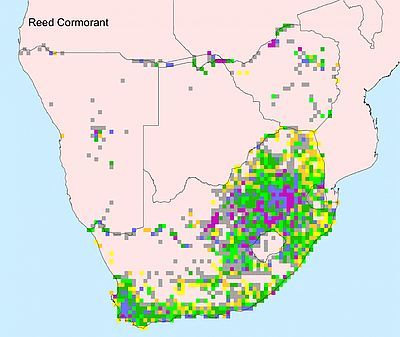
Habitat
Freshwater wetlands, occasionally at the coast. It can occupy almost any freshwater habitat, excluding very fast-flowing streams, but it generally prefers bodies of water with gently sloping shores.
Movements and migrations: Resident and partially migratory, generally moving to coastal areas in winter and inland waters in summer.
Diet
It mainly eats a wide variety of fish and frogs, hunting by pursuing them through the water using its large webbed feet. It can dive to considerable depths, but usually feeds in shallow water. It frequently brings prey to the surface.
Breeding
Monogamous and usually colonial, joining other waterbirds such as Cattle egrets, African darters and Grey and Black-headed herons in colonies of 10-50 breeding pairs. The male selects the nest site and promptly displays to passing females by thrusting its head back and forwards while flapping its wings. The nest is built by both sexes in about a week, consisting of a messy platform of sticks and dead reeds, with a cup in the centre which is lined with grass. It is typically placed in the fork of a tree over water, or in a large reedbed or even on the ground. Egg-laying season is year-round, peaking from August-October in the Western Cape and from October-January elsewhere. The female lays 1-6, usually 3-4 eggs, which are incubated by both sexes for about 23-24 days. The chicks are fed by both parents, leaving the nest after about three weeks. They become fully independent about four weeks after fledging.
Call
Mostly silent away from colonies.
Status
Widespread, resident.
Order: Suliformes. Family: Phalacrocoracidae
Description
Size: 60 cm. Weight: 580 g. Wingspan: 90 cm. This is a small cormorant at 50–55 cm length and an 85 cm wingspan. It is mainly black, glossed green, in the breeding season. The wing coverts are silvery. It has a longish tail. Adults with all-black bodies (male with small crest on forehead) and grey-brown speckled wings. Both sexes have yellow to reddish facial skin and ruby red eyes, the bill is yellow. In breeding plumage, the adult has a yellow-orange face patch and throat, and a small crest. Some southern races retain the crest all year round.
Sexes are similar, but non-breeding adults and juveniles are browner, with a white belly. The underparts in young birds are entirely white, not off white as in juvenile White-breasted Cormorants.
Distribution
Across much of sub-Saharan Africa; within southern Africa common in Zimbabwe, northern and eastern Botswana, patches of Namibia, Mozambique and much of South Africa, largely excluding the arid Kalahari.

Habitat
Freshwater wetlands, occasionally at the coast. It can occupy almost any freshwater habitat, excluding very fast-flowing streams, but it generally prefers bodies of water with gently sloping shores.
Movements and migrations: Resident and partially migratory, generally moving to coastal areas in winter and inland waters in summer.
Diet
It mainly eats a wide variety of fish and frogs, hunting by pursuing them through the water using its large webbed feet. It can dive to considerable depths, but usually feeds in shallow water. It frequently brings prey to the surface.
Breeding
Monogamous and usually colonial, joining other waterbirds such as Cattle egrets, African darters and Grey and Black-headed herons in colonies of 10-50 breeding pairs. The male selects the nest site and promptly displays to passing females by thrusting its head back and forwards while flapping its wings. The nest is built by both sexes in about a week, consisting of a messy platform of sticks and dead reeds, with a cup in the centre which is lined with grass. It is typically placed in the fork of a tree over water, or in a large reedbed or even on the ground. Egg-laying season is year-round, peaking from August-October in the Western Cape and from October-January elsewhere. The female lays 1-6, usually 3-4 eggs, which are incubated by both sexes for about 23-24 days. The chicks are fed by both parents, leaving the nest after about three weeks. They become fully independent about four weeks after fledging.
Call
Mostly silent away from colonies.
Status
Widespread, resident.
- Bushveld Jock
- Posts: 2001
- Joined: Sat Jun 02, 2012 3:52 pm
- Contact:
Reed Cormorant Photos
058. Reed Cormorant Microcarbo africanus
 © PRWIN
© PRWIN
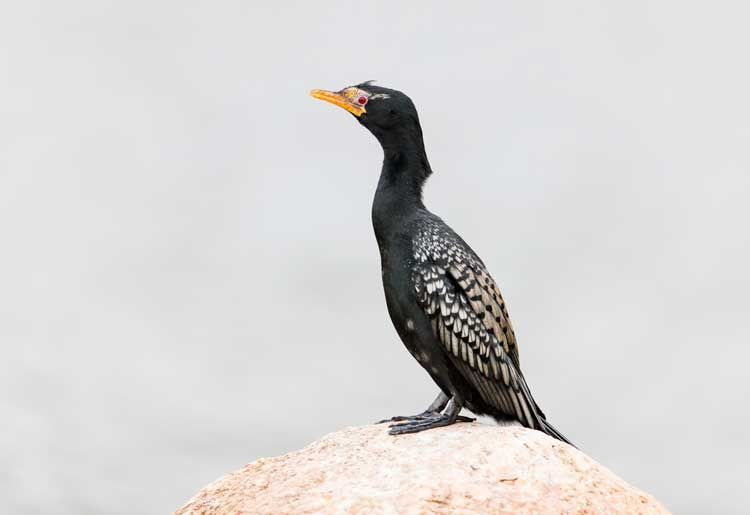 © Pumbaa
© Pumbaa
Kruger National Park, Feb 2020
 © Joan
© Joan
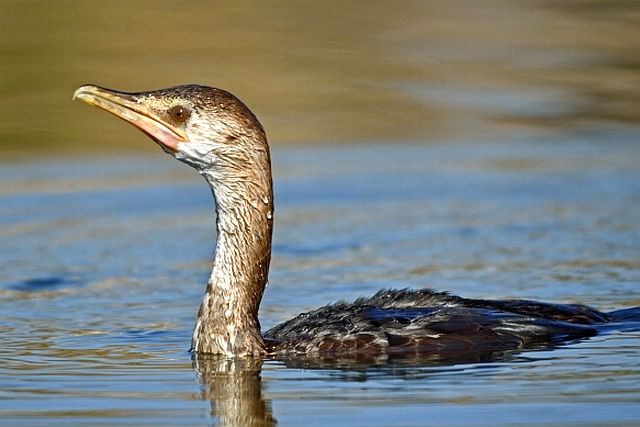 © BluTuna
© BluTuna
 © Toko
© Toko
Juveniles, Kosi Bay
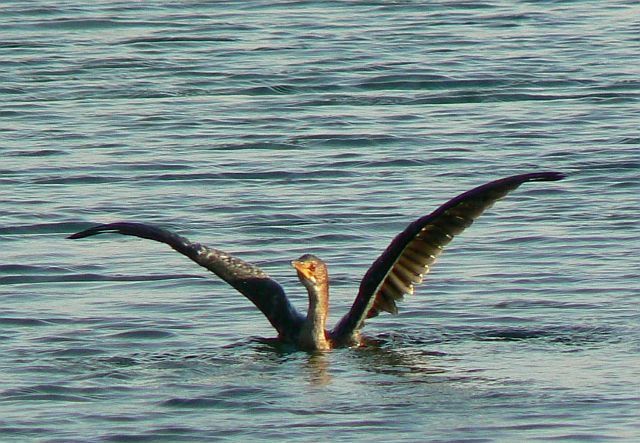 © Toko
© Toko
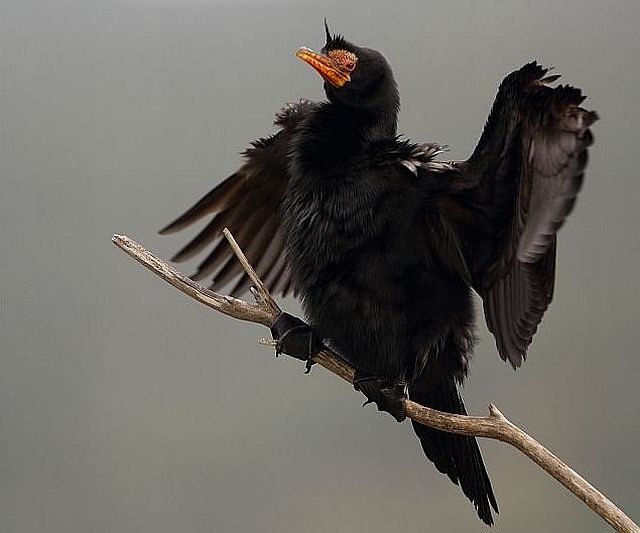 © Sharifa
© Sharifa
Wilderness
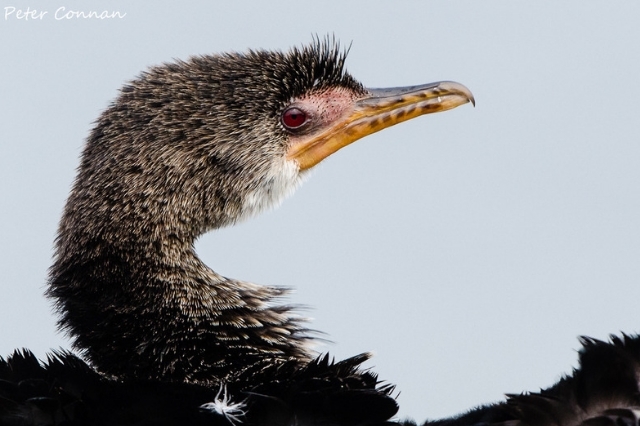 © Peter Connan
© Peter Connan
Marievale, Gauteng
Links:
Sabap2
Species Text Sabap1
 © PRWIN
© PRWIN © Pumbaa
© PumbaaKruger National Park, Feb 2020
 © Joan
© Joan © BluTuna
© BluTuna © Toko
© TokoJuveniles, Kosi Bay
 © Toko
© Toko © Sharifa
© SharifaWilderness
 © Peter Connan
© Peter ConnanMarievale, Gauteng
Links:
Sabap2
Species Text Sabap1
Crowned Cormorant
059. Crowned Cormorant Microcarbo coronatus (Kuifkopduiker)
Order: Suliformes. Family: Phalacrocoracidae
Description
The smallest of the marine cormorants, length 54 cm, mass 670-880 g; males larger than females.
Breeding adult: Glossy black with white filoplumes on the sides of the head; scapulars and wing-coverts have grey-brown centres. The crest on the forecrown is usually partially erect. The bill is black with a yellow-orange base to the lower mandible; the gape is orange. The eye is red, as is the skin above and in front of the eye.
Non-breeding adult: Paler and browner than when breeding; bare parts duller.
immatures are brown.
Similar species: Similar to Reed Cormorant, but exclusively marine; tail somewhat shorter; crest longer and often conspicuous on forecrown; black tips to scapulars and upperwing coverts narrower. Red eye distinguishes it from other marine cormorants. Cape Cormorant and Bank Cormorant are larger, have longer bills and shorter tails, and lack the prominent crest.
Taxonomy
This species has previously been considered a subspecies of the Reed Cormorant. Often placed in genus Phalacrocorax.
Distribution
Endemic to the west coast of southern Africa. The Crowned Cormorant occurs only in Namibia and South Africa, breeding between the Bird Rock Guano Platform in southern Namibia and Quoin Rock, South Africa.
Habitat
Rocky areas of coast the coastline and offshore islands, while large absent from freshwater habitats. They generally occur within 10 km from the coastline, and occasionally in estuaries and sewage works up to 500 m from the sea.
Diet
It mainly eats klipfish, doing most of it foraging in rock pools and in the breaking waves, pursuing its prey underwater in bouts of roughly 7-59 seconds. Its jaw is adapted to handling slow-moving, bottom-dwelling fish, as it struggles to catch more fast moving prey.
Breeding
Monogamous, colonial nester, nesting in small colonies with less than 30 nests, often within a larger colony of other seabirds, herons and egrets. The male displays at his nest site, puffing its feathers and rapidly jerking his head backward and forward. The nest is mainly built by the female, consisting of a platform of sticks, dry seaweed, feathers and bones, often stained pink with guano. It is typically placed on an island or some other site which is inaccessible to mammalian predators, such as a cliff, ledge, wrecked ship, boulder, moored boat, pier or rocky outcrop. Egg-laying season is year-round, peaking from September-March. It lays 1-5 eggs, which are incubated by both sexes for 21-23 days. The chicks leave the nest at about 12 days old for the rocks and sea adjacent to the colony, taking their first flight at roughly 35 days old and becoming fully independent about 10-25 days later.
Status
Fairly common endemic resident. This species is listed as Near Threatened on the IUCN Red List.
Order: Suliformes. Family: Phalacrocoracidae
Description
The smallest of the marine cormorants, length 54 cm, mass 670-880 g; males larger than females.
Breeding adult: Glossy black with white filoplumes on the sides of the head; scapulars and wing-coverts have grey-brown centres. The crest on the forecrown is usually partially erect. The bill is black with a yellow-orange base to the lower mandible; the gape is orange. The eye is red, as is the skin above and in front of the eye.
Non-breeding adult: Paler and browner than when breeding; bare parts duller.
immatures are brown.
Similar species: Similar to Reed Cormorant, but exclusively marine; tail somewhat shorter; crest longer and often conspicuous on forecrown; black tips to scapulars and upperwing coverts narrower. Red eye distinguishes it from other marine cormorants. Cape Cormorant and Bank Cormorant are larger, have longer bills and shorter tails, and lack the prominent crest.
Taxonomy
This species has previously been considered a subspecies of the Reed Cormorant. Often placed in genus Phalacrocorax.
Distribution
Endemic to the west coast of southern Africa. The Crowned Cormorant occurs only in Namibia and South Africa, breeding between the Bird Rock Guano Platform in southern Namibia and Quoin Rock, South Africa.
Habitat
Rocky areas of coast the coastline and offshore islands, while large absent from freshwater habitats. They generally occur within 10 km from the coastline, and occasionally in estuaries and sewage works up to 500 m from the sea.
Diet
It mainly eats klipfish, doing most of it foraging in rock pools and in the breaking waves, pursuing its prey underwater in bouts of roughly 7-59 seconds. Its jaw is adapted to handling slow-moving, bottom-dwelling fish, as it struggles to catch more fast moving prey.
Breeding
Monogamous, colonial nester, nesting in small colonies with less than 30 nests, often within a larger colony of other seabirds, herons and egrets. The male displays at his nest site, puffing its feathers and rapidly jerking his head backward and forward. The nest is mainly built by the female, consisting of a platform of sticks, dry seaweed, feathers and bones, often stained pink with guano. It is typically placed on an island or some other site which is inaccessible to mammalian predators, such as a cliff, ledge, wrecked ship, boulder, moored boat, pier or rocky outcrop. Egg-laying season is year-round, peaking from September-March. It lays 1-5 eggs, which are incubated by both sexes for 21-23 days. The chicks leave the nest at about 12 days old for the rocks and sea adjacent to the colony, taking their first flight at roughly 35 days old and becoming fully independent about 10-25 days later.
Status
Fairly common endemic resident. This species is listed as Near Threatened on the IUCN Red List.
Crowned Cormorant Photos
059. Crowned Cormorant Microcarbo coronatus
 © harrys
© harrys
Cape Town, Melkbos strand
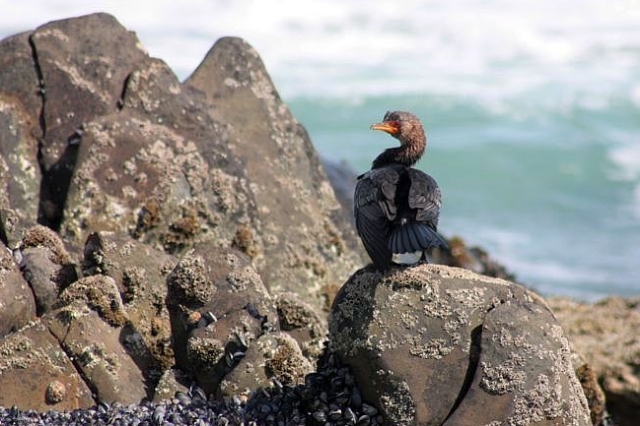 © harrys
© harrys
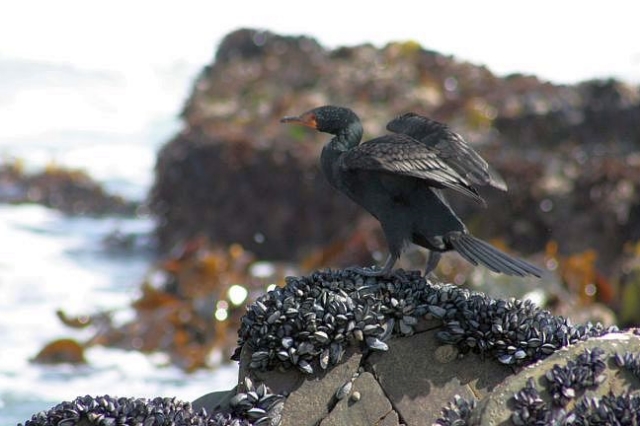 © harrys
© harrys
Cape Town, Melkbos strand
Links:
Sabap2: http://sabap2.adu.org.za/spp_summary.ph ... §ion=3
Species text in The Atlas of Southern African Birds: http://sabap2.adu.org.za/docs/sabap1/059.pdf
 © harrys
© harrysCape Town, Melkbos strand
 © harrys
© harrys © harrys
© harrysCape Town, Melkbos strand
Links:
Sabap2: http://sabap2.adu.org.za/spp_summary.ph ... §ion=3
Species text in The Atlas of Southern African Birds: http://sabap2.adu.org.za/docs/sabap1/059.pdf
Bank Cormorant
057. Bank Cormorant Phalacrocorax neglectus (Bankduiker)
Order: Suliformes Family: Phalacrocoracidae
Description
Length 75-76 cm, mass 1.5-2.4 kg; males larger than females. A large, robust, black cormorant.
Breeding adult: Plumage black with a white rump and white filoplumes on the sides of the head. A small crest on the forecrown gives the impression of a steep forehead and flat crown. The top half of the eye is orange brown, and the lower half is green or turquoise. The bill, eye-ring, bare gular pouch, legs and feet are black.
Non-breeding adult: Lacks white plumage, body browner.
Similar species: Larger and more robust than Cape Cormorant, from which it also differs by its dull black plumage and thick, woolly-textured neck, and by the lack of yellow facial skin. The Cape Cormorant is more slender and slightly smaller, with a thinner neck and thinner bill. It lacks the peaked forecrown and has an orange-yellow facial skin.
Distribution
Endemic to southern Africa's western coast, from Namibia down to the Northern and Western Cape. Breeding from Hollamsbird Island, Namibia to Quoin Rock, South Africa. The non-breeding range extends further north from Hoanibmond in northern Namibia to Die Walle in the Western Cape, South Africa.
Habitat
Inshore coastal. It generally stays close to the coastline, especially within the kelp zone, rarely moving further out to sea.
Movements and migrations
Adults generally stay within roughly 10 km of their breeding site, although juveniles disperse and travel much longer distances after fledging.
Diet
It eats fish and aquatic invertebrates, doing most of its foraging alone among kelp beds, descending to the sea floor to catch slow-moving bottom-dwellers. It dives in stints of 26-80 seconds, often descending to a depth of at least 28 metres. They prey on various fish, crustaceans and cephalopods, feeding mainly amongst kelp beds where they catch Cape Rock Lobster Jasus lalandii, with Pelagic Goby Sufflogobius bibarbatus taken in mid-water.
Breeding
A monogamous colony breeder, typically nesting in colonies of 20-100 pairs, with the male performing a display in which he throws head forward and backward repeatedly. The nest is built by both sexes, consisting of a large platform built largely of fresh seaweed with a few sticks and feathers. It is typically placed on coastal islands, cliffs, boulders, walls, inshore rocks or artificial platforms next to the sea. Egg-laying season is year-round, peaking from May-October in the Western Cape and from November-April in Namibia. It lays 1-3 chalky white eggs, which are incubated by both sexes for about 28-32 days. The chicks start exploring the area around the nest at about 50 days old, taking their first flight at 55-70 days old and becoming fully independent roughly three months later.
Status
Locally common endemic resident. Previously classified as Vulnerable, its status has since worsened to Endangered, as its population has decreased by at least 50% in the last three generations. Its largest colony (on Ichaboe Island, Namibia) is contracting in size due to a collapse in the stocks of Pelagic goby (Sufflogobius pusillus). This combined with general food scarcity, human disturbance and competition for space with Cape fur seals (Arctocephalus pusillus) has been responsible for decreases in population on other islands and breeding sites.
Order: Suliformes Family: Phalacrocoracidae
Description
Length 75-76 cm, mass 1.5-2.4 kg; males larger than females. A large, robust, black cormorant.
Breeding adult: Plumage black with a white rump and white filoplumes on the sides of the head. A small crest on the forecrown gives the impression of a steep forehead and flat crown. The top half of the eye is orange brown, and the lower half is green or turquoise. The bill, eye-ring, bare gular pouch, legs and feet are black.
Non-breeding adult: Lacks white plumage, body browner.
Similar species: Larger and more robust than Cape Cormorant, from which it also differs by its dull black plumage and thick, woolly-textured neck, and by the lack of yellow facial skin. The Cape Cormorant is more slender and slightly smaller, with a thinner neck and thinner bill. It lacks the peaked forecrown and has an orange-yellow facial skin.
Distribution
Endemic to southern Africa's western coast, from Namibia down to the Northern and Western Cape. Breeding from Hollamsbird Island, Namibia to Quoin Rock, South Africa. The non-breeding range extends further north from Hoanibmond in northern Namibia to Die Walle in the Western Cape, South Africa.
Habitat
Inshore coastal. It generally stays close to the coastline, especially within the kelp zone, rarely moving further out to sea.
Movements and migrations
Adults generally stay within roughly 10 km of their breeding site, although juveniles disperse and travel much longer distances after fledging.
Diet
It eats fish and aquatic invertebrates, doing most of its foraging alone among kelp beds, descending to the sea floor to catch slow-moving bottom-dwellers. It dives in stints of 26-80 seconds, often descending to a depth of at least 28 metres. They prey on various fish, crustaceans and cephalopods, feeding mainly amongst kelp beds where they catch Cape Rock Lobster Jasus lalandii, with Pelagic Goby Sufflogobius bibarbatus taken in mid-water.
Breeding
A monogamous colony breeder, typically nesting in colonies of 20-100 pairs, with the male performing a display in which he throws head forward and backward repeatedly. The nest is built by both sexes, consisting of a large platform built largely of fresh seaweed with a few sticks and feathers. It is typically placed on coastal islands, cliffs, boulders, walls, inshore rocks or artificial platforms next to the sea. Egg-laying season is year-round, peaking from May-October in the Western Cape and from November-April in Namibia. It lays 1-3 chalky white eggs, which are incubated by both sexes for about 28-32 days. The chicks start exploring the area around the nest at about 50 days old, taking their first flight at 55-70 days old and becoming fully independent roughly three months later.
Status
Locally common endemic resident. Previously classified as Vulnerable, its status has since worsened to Endangered, as its population has decreased by at least 50% in the last three generations. Its largest colony (on Ichaboe Island, Namibia) is contracting in size due to a collapse in the stocks of Pelagic goby (Sufflogobius pusillus). This combined with general food scarcity, human disturbance and competition for space with Cape fur seals (Arctocephalus pusillus) has been responsible for decreases in population on other islands and breeding sites.
Bank Cormorant Photos
057. Bank Cormorant Phalacrocorax neglectus
 © Dewi
© Dewi
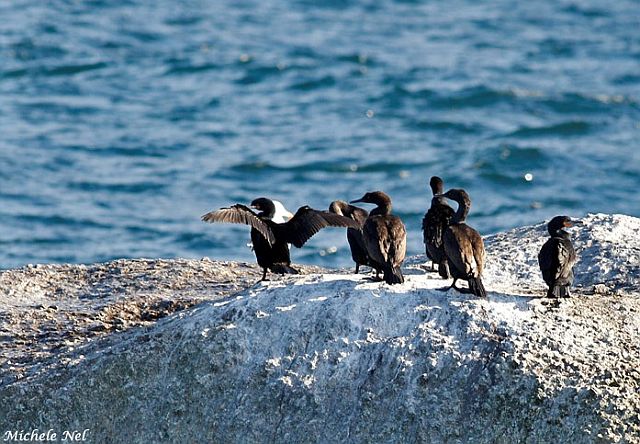 © Michele Nel
© Michele Nel
Links:
Species text in The Atlas of Southern African Birds: http://sabap2.adu.org.za/docs/sabap1/057.pdf
Sabap2: http://sabap2.adu.org.za/spp_summary.ph ... §ion=3
Threat Thursday, focusing on the "Endangered" Bank Cormorant,
Animal Demography Unit of the University of Cape Town,
ARKive: http://www.arkive.org/bank-cormorant/ph ... neglectus/
Cruising for cormorants along the Atlantic Ocean coastline
 © Dewi
© Dewi © Michele Nel
© Michele NelLinks:
Species text in The Atlas of Southern African Birds: http://sabap2.adu.org.za/docs/sabap1/057.pdf
Sabap2: http://sabap2.adu.org.za/spp_summary.ph ... §ion=3
Threat Thursday, focusing on the "Endangered" Bank Cormorant,
Animal Demography Unit of the University of Cape Town,
ARKive: http://www.arkive.org/bank-cormorant/ph ... neglectus/
Cruising for cormorants along the Atlantic Ocean coastline
White-breasted Cormorant
055. White-breasted Cormorant Phalacrocorax lucidus (Witborsduiker)
Order: Pelecaniformes. Family: Phalacrocoracidae.
Taxonomy
The African white-breasted cormorant, Phalacrocorax lucidus, was only recently split from the Great black cormorant, Phalacrocorax carbo. However, some authorities still consider this to be a subspecies or allospecies of the Great black cormorant.
Description
Wingspan 121-149 cm. Length 77-94 cm. A large water bird with long neck, which you often see standing upright on a post, tree or rock with their wings held out to dry. Adults have dark plumage overall, with a bluish gloss to it. The breast and lower neck are sparkling white. Their wings are slightly more brown and their face and gular region are yellow, bordered with small, white feathers. At the base of the pale greyish bill is an area of bare, yellow skin surrounded by white. African populations tend to have extensive white portions of their head and neck. The eyes are green.
In the breeding season their heads and necks develop short, white plumes interspersed in their dark plumage. and throughout the year a variable amount of white. They also develop a white patch on each thigh. During egg-laying adults develop a small yellow to scarlet patch behind and below each eye.
Immature individuals may be more brown or mottled in appearance and have entirely white underparts.
Similar species: Immatures resemble Reed Cormorants, but the immature of the Reed Cormorant have off-white underparts. The Reed Cormorant has an red eye.
Distribution
Occurs in patches of sub-Saharan Africa; in southern Africa it is common in Zimbabwe, much of South Africa (largely excluding the arid Kalahari) and central and western Namibia, while more scarce in northern and eastern Botswana and patches of Mozambique.
Habitat
It can occur in almost any aquatic habitat, such as dams, streams, rivers, estuaries and the coast.
Diet
It mainly eats fish, doing most of its foraging 10-200 metres from the shoreline (when foraging at sea), diving in stints of up to about 82 seconds, although considerably less in freshwater. Its jaw is adapted to handling bottom-dwelling slow-moving fish, but it may catch faster fish that live closer to the surface. Smaller fish may be swallowed underwater, but with larger fish it has to take them to shore: in one case a bird died of suffocation after attempting to swallow a large Carp.
Breeding
Usually a monogamous, colonial nester, typically living in colonies of under 50 breeding pairs, although colonies of been recorded with over 700 breeding pairs. It is often joined by other breeding birds, such as Reed cormorants, African darters, African spoonbills, Cattle egrets and other herons.
The nest is built in roughly a week by the female, with material collected by the male, consisting of a flat platform of sticks and twigs and feathers, sometimes with seaweed and human debris. It is typically placed at a largely predator-free site, such as an island, cliff ledge, man-made guano pile, shipwreck, pylon, pan wall or the shoreline of a dams or river. Egg-laying season is year-round, peaking from September-December in the Western Cape and from January-July elsewhere. It lays 2-5, usually 3-4 eggs, which are incubated by both sexes for about 27-28 days. The chicks are fed by both parents by regurgitation, leaving the nest at about 28 days old. They fledge at about 49-56 days old, becoming fully independent after another 40-50 days or so.
Status
Common resident.
Order: Pelecaniformes. Family: Phalacrocoracidae.
Taxonomy
The African white-breasted cormorant, Phalacrocorax lucidus, was only recently split from the Great black cormorant, Phalacrocorax carbo. However, some authorities still consider this to be a subspecies or allospecies of the Great black cormorant.
Description
Wingspan 121-149 cm. Length 77-94 cm. A large water bird with long neck, which you often see standing upright on a post, tree or rock with their wings held out to dry. Adults have dark plumage overall, with a bluish gloss to it. The breast and lower neck are sparkling white. Their wings are slightly more brown and their face and gular region are yellow, bordered with small, white feathers. At the base of the pale greyish bill is an area of bare, yellow skin surrounded by white. African populations tend to have extensive white portions of their head and neck. The eyes are green.
In the breeding season their heads and necks develop short, white plumes interspersed in their dark plumage. and throughout the year a variable amount of white. They also develop a white patch on each thigh. During egg-laying adults develop a small yellow to scarlet patch behind and below each eye.
Immature individuals may be more brown or mottled in appearance and have entirely white underparts.
Similar species: Immatures resemble Reed Cormorants, but the immature of the Reed Cormorant have off-white underparts. The Reed Cormorant has an red eye.
Distribution
Occurs in patches of sub-Saharan Africa; in southern Africa it is common in Zimbabwe, much of South Africa (largely excluding the arid Kalahari) and central and western Namibia, while more scarce in northern and eastern Botswana and patches of Mozambique.
Habitat
It can occur in almost any aquatic habitat, such as dams, streams, rivers, estuaries and the coast.
Diet
It mainly eats fish, doing most of its foraging 10-200 metres from the shoreline (when foraging at sea), diving in stints of up to about 82 seconds, although considerably less in freshwater. Its jaw is adapted to handling bottom-dwelling slow-moving fish, but it may catch faster fish that live closer to the surface. Smaller fish may be swallowed underwater, but with larger fish it has to take them to shore: in one case a bird died of suffocation after attempting to swallow a large Carp.
Breeding
Usually a monogamous, colonial nester, typically living in colonies of under 50 breeding pairs, although colonies of been recorded with over 700 breeding pairs. It is often joined by other breeding birds, such as Reed cormorants, African darters, African spoonbills, Cattle egrets and other herons.
The nest is built in roughly a week by the female, with material collected by the male, consisting of a flat platform of sticks and twigs and feathers, sometimes with seaweed and human debris. It is typically placed at a largely predator-free site, such as an island, cliff ledge, man-made guano pile, shipwreck, pylon, pan wall or the shoreline of a dams or river. Egg-laying season is year-round, peaking from September-December in the Western Cape and from January-July elsewhere. It lays 2-5, usually 3-4 eggs, which are incubated by both sexes for about 27-28 days. The chicks are fed by both parents by regurgitation, leaving the nest at about 28 days old. They fledge at about 49-56 days old, becoming fully independent after another 40-50 days or so.
Status
Common resident.
White-breasted Cormorant Photos
055. White-breasted Cormorant Phalacrocorax lucidus
 © Toko
© Toko
Lamberts Bay, Western Cape
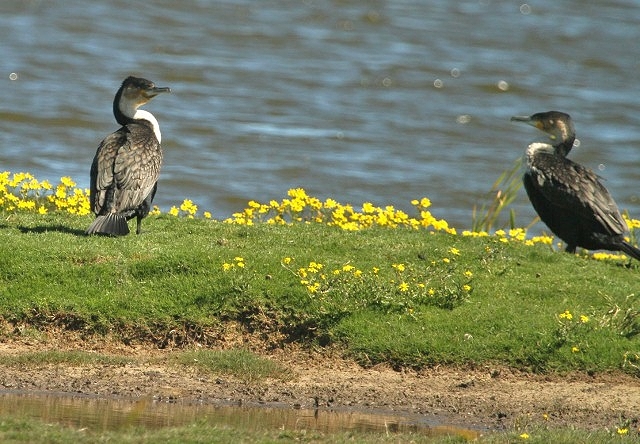 © nan
© nan
 © Michele Nel
© Michele Nel
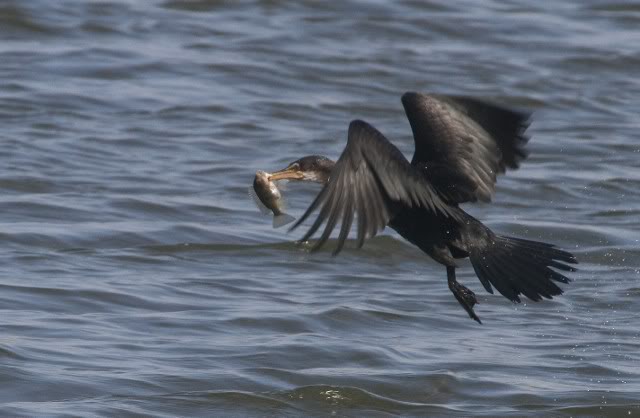 © nan
© nan
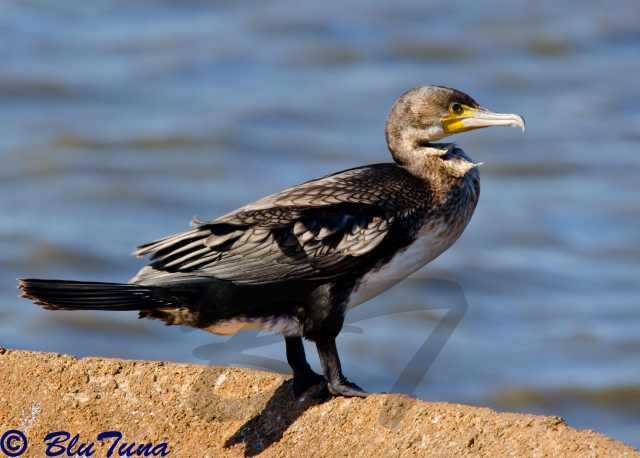 © BluTuna
© BluTuna
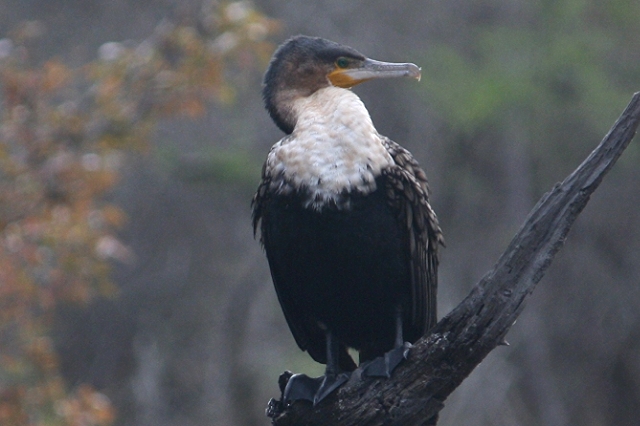 © Tina
© Tina
Kruger National Park, Lake Panic
Links:
Species text in The Atlas of Southern African Birds
Sabap2
Cruising for cormorants along the Atlantic Ocean coastline
 © Toko
© TokoLamberts Bay, Western Cape
 © nan
© nan © Michele Nel
© Michele Nel © nan
© nan © BluTuna
© BluTuna © Tina
© TinaKruger National Park, Lake Panic
Links:
Species text in The Atlas of Southern African Birds
Sabap2
Cruising for cormorants along the Atlantic Ocean coastline


